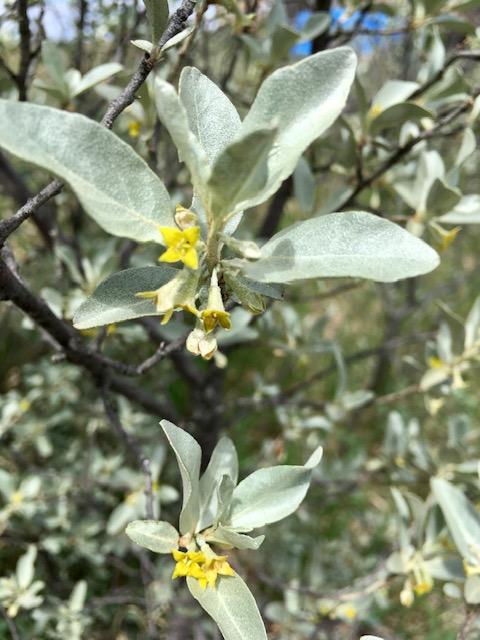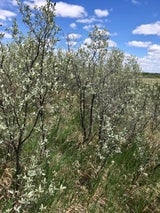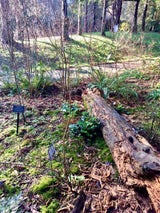- In the Garden
- >
- Gardens
- >
- Gardens A-D
- >
- BC Habitat Garden
- >
- Elaeagnus commutata
Elaeagnus commutata
Wolf willow or silver berry (Elaeagnus commutata) is a North American native shrub that enriches the natural world around it. A plant that just keeps giving in every direction and season. This medium-sized deciduous shrub provides nitrogen for other plants as well as food and cover for many insects and animals. Elk and moose eat the plants in wintertime. Birds have increased populations in grasslands where wolf willow grows.
Its fragrant flowers in spring and summer provide vital nectar for native bees. Like a lot of shrubs in the Elaeagnus family, wolf willow can be invasive from its vigorous root system. It reproduces by rhizomes (underground stems) and seeds. And that is good. More pollinators, more birds, more cover for animals big and small. When wolf willow is planted in orchards, it even increases fruit yield.
First Nations know the value of this plant. Its fruit is a dry silvery berry with a large seed with striped markings. These seeds become attractive beads in necklaces or other decorations. When used as a food source, this seed is edible both cooked and raw. These berries are packed with nutrition - vitamins, minerals, and essential fatty acids. A gift any time but especially in times of hunger. Even the bark has something to give - it is used in weaving and rope making.
Wolf willow rehabilitates too. Adapting well to disturbed sights, it is used for rehabilitating mine spoils in British Columbia and Alberta. Its rhizomes help prevent soil erosion. At Fort McMurray, Alberta, wolf willow spreads rapidly on amended tailings sand.
Wolf willow is the common name most people use for this shrub, yet it doesn’t look much like a willow and wolves aren’t attracted to it. This plant is a nitrogen fixer, enriching the soil wherever it grows. In the past, people used to believe these fast-spreading plants ate up (wolf downed) the soil. It’s a good common name to hang on to, though. Wolves help take care of the balance in nature, and willow heals.
The pictures of the mature wolf willow were taken in June at a natural area near Saskatoon. I was lucky to be there when it was in bloom. The jasmine-like smell was intoxicating. You could still see the small flowers as wolf willow was just beginning to leaf out. The two pictures of a young wolf willow in winter were taken in the BC Habitat Garden at VanDusen.
Text and photos by Hughie Jones
The watercolour of wolf willow was painted by the ‘Audubon of Botany’, Mary Vaux Walcott






